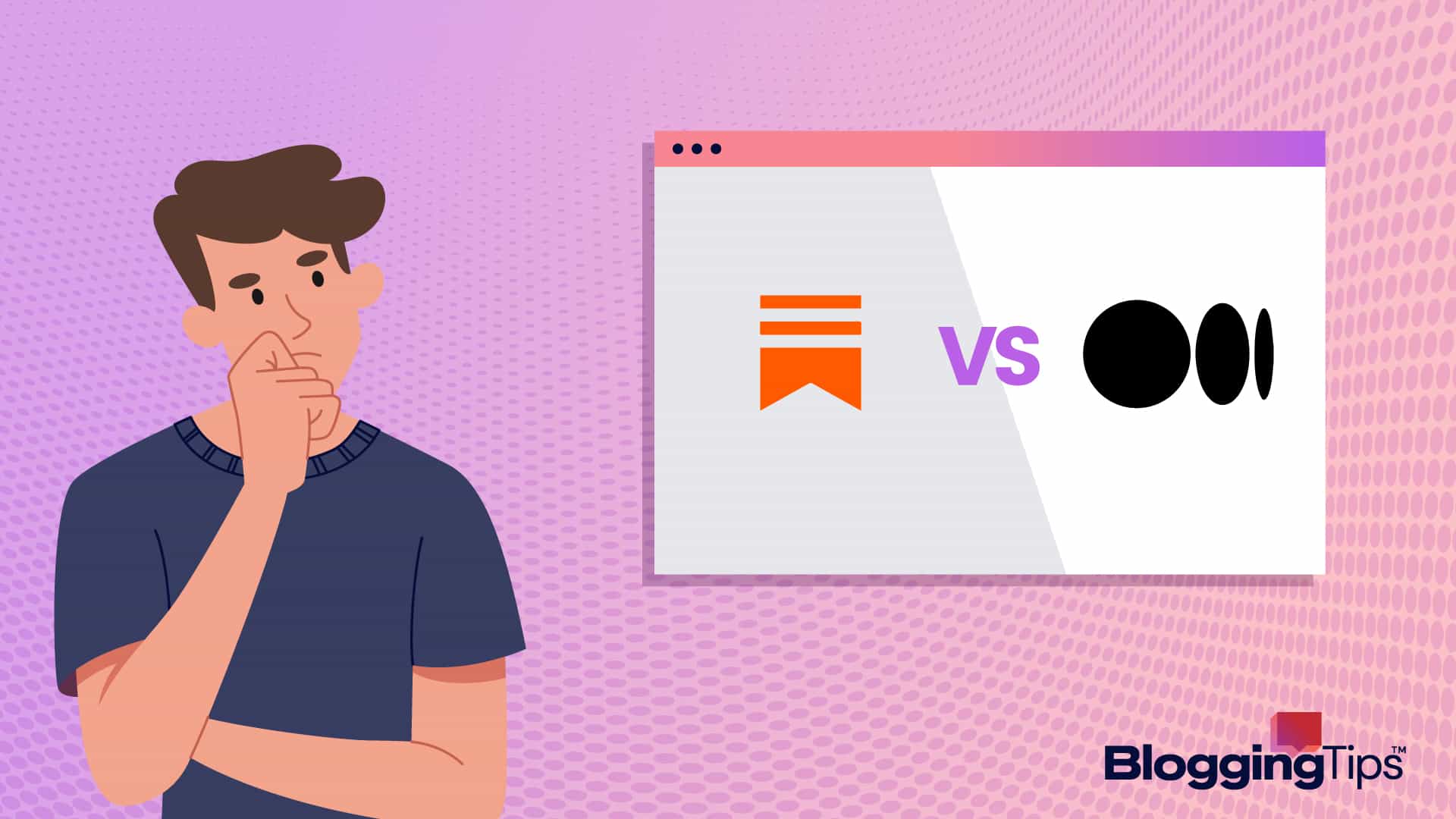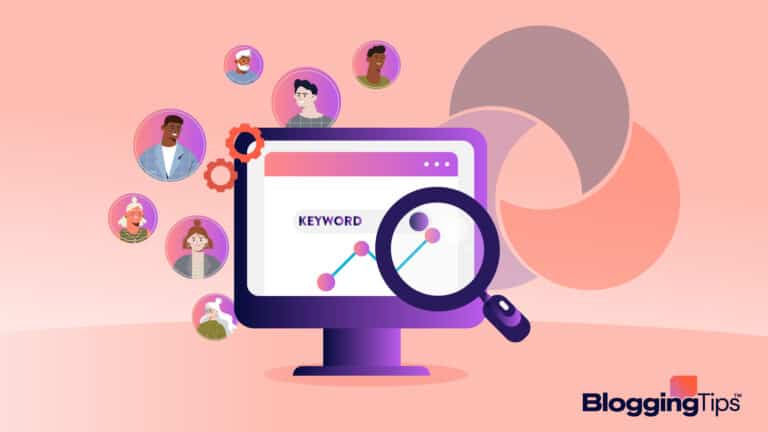Are you a writer looking for the best blogging platforms to share your work?
Without going through the hassle of creating and managing your own blog, Substack and Medium are two platforms that take care of the tedious technical task and let you focus on what you do best – writing.
On top of that, you can make money writing on these two platforms. Whether you are a full-time blogger or just can’t stop writing for fun.
While they both make it easy for you to write, publish and monetize your blog. There’s a huge difference in how they operate.
In this guide, we’ll pit both platforms side by side. And by the end of this guide, you’ll have everything to decide on the best platform to start your free blog site.
- Substack vs. Medium: Overview
- Substack vs. Medium: Who Can Publish On It?
- Substack vs. Medium: How Hard is it to Make Money?
- Substack vs. Medium: How Much Does it Cost to Publish?
- Substack vs. Medium: Who Owns the Content?
- Can You Use Both Medium and Substack?
- Can You Publish the Same Article on Medium and Substack?
- Frequently Asked Questions
- Wrapping up
Substack vs. Medium: Overview
Before deciding which platform is right for you, let’s first understand what both platforms stand for.
What is substack?
Substack is a subscription-based platform that allows writers and content creators to monetize their work.
While it enables creators to share content for free, the platform functions primarily as a newsletter subscription service. It simplifies the email marketing process for writers.
Substack focuses majorly on helping writers monetize their audiences.
Although the platform is more popular among writers looking for a zero-technical avenue to publish their content, it’s also used by podcasters, journalists and other internet publishers who seek to put their work behind paywalls and enjoy an all-in-one email marketing solution.
How Substack works
Contents, articles and newsletters on Substack are called publications, and anyone with an email can start by visiting the Substack website.
Substack provides tools to help writers create and publish articles and built-in newsletter management tools. Creators can monetize their content right off the bat by setting up subscriptions starting at $5 per month.
Of course, you can publish free content on your Substack blog. You only get to pay when you set up a premium subscription.
Substack charges up to 10% of each subscriber’s payment. That’s how the company makes money.
With Substack, the job of building audience and readership is on the creator. Substack only provides tools for publishing, managing email lists and sending newsletters. The onus is on the writer to promote their work.
Features of Substack
- Custom Domains: Instead of the Substack subdomain. The platform allows users to add custom domains for a one-time payment of $50.
- Native Analytics: Substack has a built-in analytics feature that allows users to track subscribers’ engagement with emails using metrics such as open rate, reading time and other metrics.
- Third-party Integration: Substack integrates with tools like Google Analytics and Mailchimp.
- Multi-author Publication: One of the most valuable features on Substack not available on Medium is this. This feature allows multiple authors to collaborate and publish their work under a single publication.
- Paid Subscriptions: Substack let writers charge a subscription fee for their work. That makes it a great place to monetize your writing and build a sustainable income and a loyal subscriber base.
- Customization: Substack allows you to customize your newsletter’s design to match your website.
- Limited Social Features: Compared to medium, Substack has fewer engagement features. Meaning it can be challenging to build a community on the platform.
- Predictable Earnings: Earning on substack is pretty straightforward. The more subscribers you get, the higher your earnings. It’s 100% predictable.
What is Medium?
Medium is an online publishing platform designed to allow writers to reach an existing, broad audience with little effort.
It’s like a social media platform for writers to connect with readers and other writers.
The platform’s personalized recommendation system suggests writers work for its large audience based on their interests and profiles.
While Medium is generally considered a written content hub, users can share audio and video content.
How Medium Works
Like Substack, getting started on Medium is simple. Simply visit the official website to sign up, verify your email and are ready to start publishing.
Once you start writing on Medium, the algorithm is like a social media timeline algorithm that exposes content to audiences based on their interests, making it easy for content to reach far and wide.
Plus, your content can rank on Google or go viral. You don’t have to build your own audience, but there’s no crime in promoting your work on social media or other channels.
Joining the Medium Partner Program is the only monetization option available on Medium.
Once you meet the eligibility criteria and are accepted into the program, you get paid for people’s engagement with your content and referrals (more on this later).
Features of Medium
- Better Social Features: Connecting with other readers and writers and building a community on Medium is easy. You can connect with readers on Medium via social features such as comments, follows, and claps (Medium’s version of likes).
- Custom Domains: Like Substack, you can give your Medium blog a branded and professional appeal by using your custom domains. This is at a subscription membership cost of $5 per month.
- Engagement Analytics: Medium gives writers insights about their content performance with metrics such as exposure and read time, audience, demography etc. Users can also see the data and breakdown of how people find their content.
- Built-in Audience: Unlike Substack, where you must build your audience. Medium already has nearly 100 million monthly active users, making it easier to reach a wider audience.
- Paid Membership: Readers on Medium pay $5 per month to access unlimited content on the platform. Free users only have access to 5 free content per month. Writers on the membership program get paid with this money.
- Limited Branding Options: Other than a custom domain, Medium has no branding flexibility, which means you can’t customize your profile or articles to look like your personal brand or website.
Substack vs. Medium: Who Can Publish On It?
As you’ve seen above, anyone can publish on both Mediums or Substack. But the type of writer you are will determine which option is ideal.
Having a clear writing goal and seeking to provide value to readers isn’t all that matters here. You must consider your commitment, sustainability and follower base to pick either of the platforms. Let’s take it one at a time.
Can Anyone Publish on Substack?
Writers who want to commit to a regular publishing schedule are better off with Substack. On substack, subscribers are always expecting your posts/newsletters.
That’s what they pay for, which makes the quality of content on Substack somewhat higher than Medium.
Are you ready to publish every single week for years? Are you willing to send 2-4 newsletters a week? If you answer no to either question. Substack is not for you.
On substack, there’s virtually no way people will find your account if you aren’t using a newsletter or actively promoting it on other channels. Substack only features top publications on its website.
Can Anyone Publish on Medium?
If you are the type of writer that wants to publish only when you have something to say, Medium is the channel you.
On Medium, Publishing 1 or 2 articles per month is okay as you don’t have subscribers awaiting publication. There’s no payment directly involved in your publication from readers, so you can publish as often or less as you deem fit.
This also indicates that Medium is ideal for you as a new writer. There’s no one there to hold you to a specific standard.
However, that doesn’t mean you should push out lame content. Only value-packed content attracts valuable audiences.
Substack vs. Medium: How Hard is it to Make Money?
Both substack and medium allow you to earn money from your work. But the earning potential of the substack is higher provided you invested the time and effort to build your audience.
How Hard is it to Make Money on Substack?
With Substack, you can earn money on the get-go since the platform allows you to monetize your publication with a paid subscription immediately upon sign-up.
Substack allows creators to set any price for their publications, with a minimum of $5. Writers keep 90% of their earnings. Plus, it’s also a predictable source of income.
For instance, if you have 1000 subscribers and charge $7/per month/ subscriber, your monthly earning will be $7,000.
You only have to deduct the Substack fee, usually 10% and the stripe payment processing fee. That’s the amount you can expect to land in your bank account.
And you don’t even need to do the calculation manually. Sub stack has a built-in earning calculator.
Another way to make money on substack is through affiliate marketing. You’re free to add affiliate links to your content. But you have to be cautious. The platform doesn’t allow publications that focus solely on affiliate promotions.
How Hard is it to Make Money on Medium?
Making money on Medium isn’t as straightforward as above. The primary monetization feature on Medium is the Partner Program. And earning from it depends on a lot of unpredictable variables.
Unlike Substack, where there are no special requirements, to be eligible for the Medium partner program, you have to:
- You must publish at least one story before applying to the program.
- You need to have gained at least 100 followers.
- You need to stay active by publishing at least once every six months.
Once you are accepted into the program, you now have two ways to earn;
- Members’ reading time and
- Referred membership
For members reading time, your earnings depend on how much time users spend reading your work. You can learn more about Calculating earnings in the Partner Program here.
For referred memberships, There are two ways you can earn.
First, as announced by Medium in 2021, every writer now has a personalized referral landing page where readers can become paying members.
Each reader who converts through your page will count as a referred member for you. You earn 50% of their membership fee as long as they keep paying.
You can promote your landing page by posting on social media, linking within your posts, or adding to your profile to maximize your earnings.
The second way to earn from the referral program is from non-paying readers. When these readers subscribe to your email, Medium prompts them to convert to members. If they do, it will count toward your referral earnings.
Like Substack, Medium also allows the use of affiliate links. You only need to disclose them to avoid penalty.
Substack vs. Medium: How Much Does it Cost to Publish?
Publishing on Medium or Substack is free. The only payment from both platforms is from readers.
You only get to pay on substack if you want to use a custom domain for your publication. And that’s a $50 one-time payment.
You don’t have to pay any amount to set up a custom domain on Medium. However, you must have an active Medium membership subscription which could cost you $5/mo or $50/yr.
Substack vs. Medium: Who Owns the Content?
Do You Own Your Content on Substack?
Substack’s Publisher’s Agreement states that you own what you create. Any of your content published on Substack remains yours and is protected by copyright.
However, Substack has limited access to your publications to operate the platform and promote your content, including distribution, marketing your newsletter and permitting others to use, access, and download them through Substack.
Do You Own Your Content on Medium?
Medium does not own the content you publish on the platform. According to the Medium Terms of Service, you retain rights to any content you submit, post or display on or through the Services.
That means you can use the content in any way that you wish. You can even republish or remove it from the platform. Medium only sub-licenses your content to distribute across their Services.
Can You Use Both Medium and Substack?
Of course, you can use both platforms. That’s one of the smartest things to do as a new writer. Medium has the audience. You can publish on Medium to capture this audience.
After a while, you can then direct them to Substack to join your subscription list for more exclusive content.
Think of it like building your email list from your blog audience. Once someone reads one of your posts, you can show them an opt-in form to join your mailing list. But this time, you are building a paying subscribers list.
Can You Publish the Same Article on Medium and Substack?
Yes, you can publish the same article on Medium and Substack. It’s your content, and you can do whatever you want with it. However, there’s a safe and risky way of doing it.
The safe way is to publish your content on Substack and then repost it to Medium using the canonical URL(URL it posted as on Substack) to tell Google the content has been published elsewhere. This way prevents any penalty from Google.
The risky way is to first publish on Medium and then to Substack. This is because Substack doesn’t support adding canonical links.
Although some writers do add anchored lines like, “This article was originally published on Medium” at the top or bottom of their content. It can only last so long. It’s not reliable.
To play it safe, use what search crawlers recognize- Canonical URLs.
Frequently Asked Questions
Now that you know the stark contrast between Substack and Medium, here are some common questions people ask about both platforms.
What is Better Than Substack?
Ghost, Patreon, Scribble and Writeas are some of the alternatives to substack. Picking a better platform than Subtack depends on your preference.
You have to check which of these platforms best supports your goals, audience and the type of writer you are.
Does Substack Pay Indian Writers?
In the past, writers from India couldn’t get paid on Substack because the platform only supports Stripe, which is not available in India.
But in mid-2020, Substack announces it now has a payment option for Indians.
Wrapping up
In summary, Medium is for everyone. Substack is for established writers. On substack, you own your audience, making it easy to build a loyal community. On Medium, the platform owns the audience.
If you are a new writer with non-existent followers, you can leverage the Medium algorithm to reach millions of readers. Plus, the chances of using SEO to rank your content on SERPs are higher on Medium than on Substack.
Substack, on the other hand, is for writers with a significant follower base. There’s no organic way to reach more audience except by marketing your substack newsletter.







